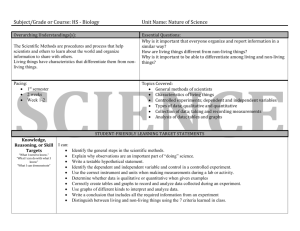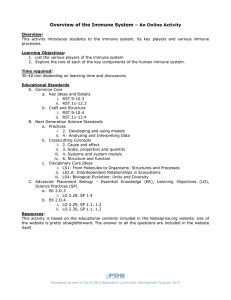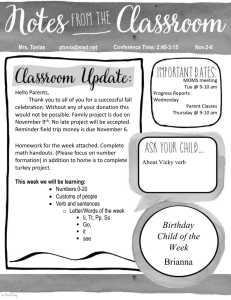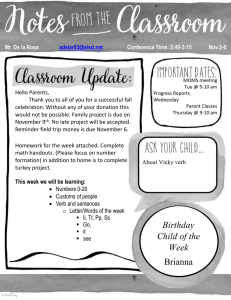400891
advertisement
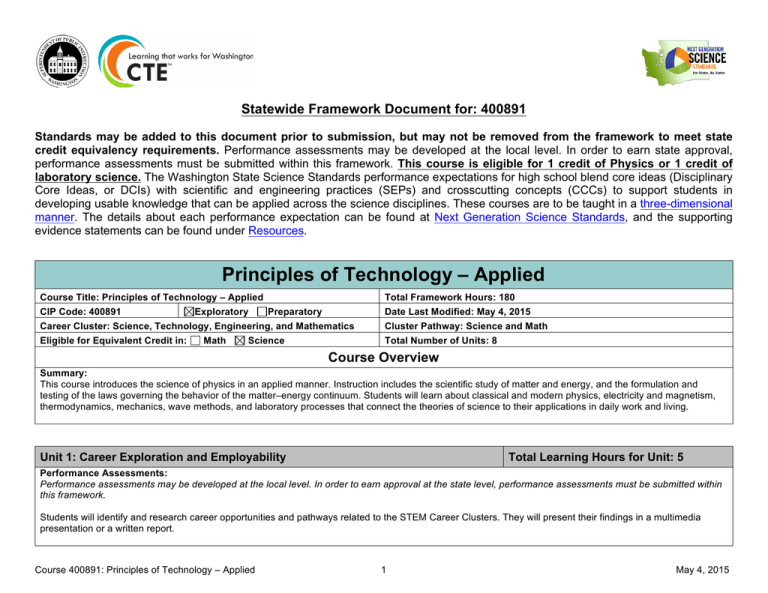
Statewide Framework Document for: 400891 Standards may be added to this document prior to submission, but may not be removed from the framework to meet state credit equivalency requirements. Performance assessments may be developed at the local level. In order to earn state approval, performance assessments must be submitted within this framework. This course is eligible for 1 credit of Physics or 1 credit of laboratory science. The Washington State Science Standards performance expectations for high school blend core ideas (Disciplinary Core Ideas, or DCIs) with scientific and engineering practices (SEPs) and crosscutting concepts (CCCs) to support students in developing usable knowledge that can be applied across the science disciplines. These courses are to be taught in a three-dimensional manner. The details about each performance expectation can be found at Next Generation Science Standards, and the supporting evidence statements can be found under Resources. Principles of Technology – Applied Course Title: Principles of Technology – Applied CIP Code: 400891 Exploratory Total Framework Hours: 180 Preparatory Date Last Modified: May 4, 2015 Career Cluster: Science, Technology, Engineering, and Mathematics Cluster Pathway: Science and Math Eligible for Equivalent Credit in: Total Number of Units: 8 Math Science Course Overview Summary: This course introduces the science of physics in an applied manner. Instruction includes the scientific study of matter and energy, and the formulation and testing of the laws governing the behavior of the matter–energy continuum. Students will learn about classical and modern physics, electricity and magnetism, thermodynamics, mechanics, wave methods, and laboratory processes that connect the theories of science to their applications in daily work and living. Unit 1: Career Exploration and Employability Total Learning Hours for Unit: 5 Performance Assessments: Performance assessments may be developed at the local level. In order to earn approval at the state level, performance assessments must be submitted within this framework. Students will identify and research career opportunities and pathways related to the STEM Career Clusters. They will present their findings in a multimedia presentation or a written report. Course 400891: Principles of Technology – Applied 1 May 4, 2015 Leadership Alignment: • Leadership activities should include 21st Century Skills embedded in curriculum and instruction for this unit of instruction. Include leadership skills that are being taught and assessed within the class for all students. • The event, activity, or project and the associated 21st Century Skill should be clearly articulated. Example: Students will demonstrate the ability to communicate clearly through their group project presentation. Aligned Washington State Standards Washington English Language Arts Standards (Common Core State Standards) - Science and Technology Literacy Standards (Grades 9-10): RST.9-10.1 Cite specific textual evidence to support analysis of science and technical texts, attending to the precise details of explanations or descriptions. RST.9-10.2 Determine the central ideas or conclusions of a text; trace the text's explanation or depiction of a complex process, phenomenon, or concept; provide an accurate summary of the text. RST.9-10.3 Follow precisely a complex multistep procedure when carrying out experiments, taking measurements, or performing technical tasks, attending to special cases or exceptions defined in the text. RST.9-10.4 Determine the meaning of symbols, key terms, and other domain-specific words and phrases as they are used in a specific scientific or technical context relevant to grades 9-10 texts and topics. RST.9-10.5 Analyze the structure of the relationships among concepts in a text, including relationships among key terms (e.g., force, friction, reaction force, energy). RST.9-10.6 Analyze the author's purpose in providing an explanation, describing a procedure, or discussing an experiment in a text, defining the question the author seeks to address. RST.9-10.7 Translate quantitative or technical information expressed in words in a text into visual form (e.g., a table or chart) and translate information expressed visually or mathematically (e.g., in an equation) into words. RST.9-10.8 Assess the extent to which the reasoning and evidence in a text support the author's claim or a recommendation for solving a scientific or technical problem. RST.9-10.9 Compare and contrast findings presented in a text to those from other sources (including their own experiments), noting when the findings support or contradict previous explanations or accounts. RST.9-10.10 By the end of grade 10, read and comprehend science/technical texts in the grades 9-10 text complexity band independently and proficiently. Unit 2: Mechanical, Fluid, Electrical, & Thermal: Force Total Learning Hours for Unit: 25 Performance Assessments: Performance assessments may be developed at the local level. In order to earn approval at the state level, performance assessments must be submitted within this framework. One possible activity: Students could build a rocket and predict how high it will fly mathematically. After launching the rocket, they can shoot an azimuth to measure angles and trigonometry to find the actual rocket trajectory. Finally, they will be able to compare their predictions to actual results. Leadership Alignment: • Leadership activities should include 21st Century Skills embedded in curriculum and instruction for this unit of instruction. Include leadership skills that are being taught and assessed within the class for all students. • The event, activity, or project and the associated 21st Century Skill should be clearly articulated. Example: Students will demonstrate the ability to communicate clearly through their group project presentation. Course 400891: Principles of Technology – Applied 2 May 4, 2015 Aligned Washington State Standards Washington Science Standards (Next Generation Science Standards): HS-PS1-5. Apply scientific principles and evidence to provide an explanation about the effects of changing the temperature or concentration of the reacting particles on the rate at which a reaction occurs. HS-PS2-1. Analyze data to support the claim that Newton’s Second Law of Motion describes the mathematical relationship among the net force on a macroscopic object, its mass, and its acceleration. HS-PS2-4. Use mathematical representations of Newton’s Law of Gravitation and Coulomb’s Law to describe and predict the gravitational and electrostatic forces between objects. HS-PS3-5. Develop and use a model of two objects interacting through electrical or magnetic fields to illustrate the forces between objects and the changes in energy of the objects due to the interaction. Washington English Language Arts Standards (Common Core State Standards) - Science and Technology Literacy Standards (Grades 9-10): RST.9-10.1 Cite specific textual evidence to support analysis of science and technical texts, attending to the precise details of explanations or descriptions. RST.9-10.2 Determine the central ideas or conclusions of a text; trace the text's explanation or depiction of a complex process, phenomenon, or concept; provide an accurate summary of the text. RST.9-10.3 Follow precisely a complex multistep procedure when carrying out experiments, taking measurements, or performing technical tasks, attending to special cases or exceptions defined in the text. RST.9-10.4 Determine the meaning of symbols, key terms, and other domain-specific words and phrases as they are used in a specific scientific or technical context relevant to grades 9-10 texts and topics. RST.9-10.5 Analyze the structure of the relationships among concepts in a text, including relationships among key terms (e.g., force, friction, reaction force, energy). RST.9-10.6 Analyze the author's purpose in providing an explanation, describing a procedure, or discussing an experiment in a text, defining the question the author seeks to address. RST.9-10.7 Translate quantitative or technical information expressed in words in a text into visual form (e.g., a table or chart) and translate information expressed visually or mathematically (e.g., in an equation) into words. RST.9-10.8 Assess the extent to which the reasoning and evidence in a text support the author's claim or a recommendation for solving a scientific or technical problem. RST.9-10.9 Compare and contrast findings presented in a text to those from other sources (including their own experiments), noting when the findings support or contradict previous explanations or accounts. RST.9-10.10 By the end of grade 10, read and comprehend science/technical texts in the grades 9-10 text complexity band independently and proficiently. Unit 3: Mechanical, Fluid, & Electrical: Work Total Learning Hours for Unit: 20 Performance Assessments: Performance assessments may be developed at the local level. In order to earn approval at the state level, performance assessments must be submitted within this framework. One possible activity: Students use fluid dynamics to determine the amount of work it will take to lift a mass of one kilogram to a height of one meter. Leadership Alignment: • Leadership activities should include 21st Century Skills embedded in curriculum and instruction for this unit of instruction. Include leadership skills that are being taught and assessed within the class for all students. • The event, activity, or project and the associated 21st Century Skill should be clearly articulated. Example: Students will demonstrate the ability to communicate clearly through their group project presentation. Course 400891: Principles of Technology – Applied 3 May 4, 2015 Aligned Washington State Standards Washington Science Standards (Next Generation Science Standards): HS-PS2-1. Analyze data to support the claim that Newton’s Second Law of Motion describes the mathematical relationship among the net force on a macroscopic object, its mass, and its acceleration. HS-PS2-4. Use mathematical representations of Newton’s Law of Gravitation and Coulomb’s Law to describe and predict the gravitational and electrostatic forces between objects. HS-ETS1-2. Design a solution to a complex real-world problem by breaking it down into smaller, more manageable problems that can be solved through engineering. Washington English Language Arts Standards (Common Core State Standards) - Science and Technology Literacy Standards (Grades 9-10): RST.9-10.1 Cite specific textual evidence to support analysis of science and technical texts, attending to the precise details of explanations or descriptions. RST.9-10.2 Determine the central ideas or conclusions of a text; trace the text's explanation or depiction of a complex process, phenomenon, or concept; provide an accurate summary of the text. RST.9-10.3 Follow precisely a complex multistep procedure when carrying out experiments, taking measurements, or performing technical tasks, attending to special cases or exceptions defined in the text. RST.9-10.4 Determine the meaning of symbols, key terms, and other domain-specific words and phrases as they are used in a specific scientific or technical context relevant to grades 9-10 texts and topics. RST.9-10.5 Analyze the structure of the relationships among concepts in a text, including relationships among key terms (e.g., force, friction, reaction force, energy). RST.9-10.6 Analyze the author's purpose in providing an explanation, describing a procedure, or discussing an experiment in a text, defining the question the author seeks to address. RST.9-10.7 Translate quantitative or technical information expressed in words in a text into visual form (e.g., a table or chart) and translate information expressed visually or mathematically (e.g., in an equation) into words. RST.9-10.8 Assess the extent to which the reasoning and evidence in a text support the author's claim or a recommendation for solving a scientific or technical problem. RST.9-10.9 Compare and contrast findings presented in a text to those from other sources (including their own experiments), noting when the findings support or contradict previous explanations or accounts. RST.9-10.10 By the end of grade 10, read and comprehend science/technical texts in the grades 9-10 text complexity band independently and proficiently. Unit 4: Mechanical, Fluid, Electrical, & Thermal: Rate Total Learning Hours for Unit: 25 Performance Assessments: Performance assessments may be developed at the local level. In order to earn approval at the state level, performance assessments must be submitted within this framework. One possible activity: Using a suspended bucket with a hole in it, students will predict the amount of time it will take to empty. They must take into account the effects of gravity as the downward force of the water in the bucket diminishes over time. Leadership Alignment: • Leadership activities should include 21st Century Skills embedded in curriculum and instruction for this unit of instruction. Include leadership skills that are being taught and assessed within the class for all students. • The event, activity, or project and the associated 21st Century Skill should be clearly articulated. Example: Students will demonstrate the ability to communicate clearly through their group project presentation. Course 400891: Principles of Technology – Applied 4 May 4, 2015 Aligned Washington State Standards Washington Science Standards (Next Generation Science Standards): HS-PS2-1. Analyze data to support the claim that Newton’s Second Law of Motion describes the mathematical relationship among the net force on a macroscopic object, its mass, and its acceleration. Washington English Language Arts Standards (Common Core State Standards) - Science and Technology Literacy Standards (Grades 9-10): RST.9-10.1 Cite specific textual evidence to support analysis of science and technical texts, attending to the precise details of explanations or descriptions. RST.9-10.2 Determine the central ideas or conclusions of a text; trace the text's explanation or depiction of a complex process, phenomenon, or concept; provide an accurate summary of the text. RST.9-10.3 Follow precisely a complex multistep procedure when carrying out experiments, taking measurements, or performing technical tasks, attending to special cases or exceptions defined in the text. RST.9-10.4 Determine the meaning of symbols, key terms, and other domain-specific words and phrases as they are used in a specific scientific or technical context relevant to grades 9-10 texts and topics. RST.9-10.5 Analyze the structure of the relationships among concepts in a text, including relationships among key terms (e.g., force, friction, reaction force, energy). RST.9-10.7 Translate quantitative or technical information expressed in words in a text into visual form (e.g., a table or chart) and translate information expressed visually or mathematically (e.g., in an equation) into words. RST.9-10.8 Assess the extent to which the reasoning and evidence in a text support the author's claim or a recommendation for solving a scientific or technical problem. RST.9-10.9 Compare and contrast findings presented in a text to those from other sources (including their own experiments), noting when the findings support or contradict previous explanations or accounts. RST.9-10.10 By the end of grade 10, read and comprehend science/technical texts in the grades 9-10 text complexity band independently and proficiently. Unit 5: Mechanical, Fluid, Electrical, & Thermal: Resistance Total Learning Hours for Unit: 25 Performance Assessments: Performance assessments may be developed at the local level. In order to earn approval at the state level, performance assessments must be submitted within this framework. One possible activity: Students create an ecologically friendly and reusable insulation system that prevents heat loss and/or heat gain. Leadership Alignment: • Leadership activities should include 21st Century Skills embedded in curriculum and instruction for this unit of instruction. Include leadership skills that are being taught and assessed within the class for all students. • The event, activity, or project and the associated 21st Century Skill should be clearly articulated. Example: Students will demonstrate the ability to communicate clearly through their group project presentation. Aligned Washington State Standards Washington Science Standards (Next Generation Science Standards): HS-PS3-4. Plan and conduct an investigation to provide evidence that the transfer of thermal energy when two components of different temperature are combined within a closed system results in a more uniform energy distribution among the components in the system (second law of thermodynamics). Course 400891: Principles of Technology – Applied 5 May 4, 2015 Washington English Language Arts Standards (Common Core State Standards) - Science and Technology Literacy Standards (Grades 9-10): RST.9-10.1 Cite specific textual evidence to support analysis of science and technical texts, attending to the precise details of explanations or descriptions. RST.9-10.2 Determine the central ideas or conclusions of a text; trace the text's explanation or depiction of a complex process, phenomenon, or concept; provide an accurate summary of the text. RST.9-10.3 Follow precisely a complex multistep procedure when carrying out experiments, taking measurements, or performing technical tasks, attending to special cases or exceptions defined in the text. RST.9-10.4 Determine the meaning of symbols, key terms, and other domain-specific words and phrases as they are used in a specific scientific or technical context relevant to grades 9-10 texts and topics. RST.9-10.5 Analyze the structure of the relationships among concepts in a text, including relationships among key terms (e.g., force, friction, reaction force, energy). RST.9-10.6 Analyze the author's purpose in providing an explanation, describing a procedure, or discussing an experiment in a text, defining the question the author seeks to address. RST.9-10.7 Translate quantitative or technical information expressed in words in a text into visual form (e.g., a table or chart) and translate information expressed visually or mathematically (e.g., in an equation) into words. RST.9-10.8 Assess the extent to which the reasoning and evidence in a text support the author's claim or a recommendation for solving a scientific or technical problem. RST.9-10.9 Compare and contrast findings presented in a text to those from other sources (including their own experiments), noting when the findings support or contradict previous explanations or accounts. RST.9-10.10 By the end of grade 10, read and comprehend science/technical texts in the grades 9-10 text complexity band independently and proficiently. Unit 6: Mechanical, Fluid, Electrical, & Thermal: Energy Total Learning Hours for Unit: 25 Performance Assessments: Performance assessments may be developed at the local level. In order to earn approval at the state level, performance assessments must be submitted within this framework. One possible activity: Students design a system that converts potential energy into mechanical energy, such as a roller coaster or a Rube Goldberg machine. Leadership Alignment: • Leadership activities should include 21st Century Skills embedded in curriculum and instruction for this unit of instruction. Include leadership skills that are being taught and assessed within the class for all students. • The event, activity, or project and the associated 21st Century Skill should be clearly articulated. Example: Students will demonstrate the ability to communicate clearly through their group project presentation. Aligned Washington State Standards Washington Science Standards (Next Generation Science Standards): HS-PS1-3. Plan and conduct an investigation to gather evidence to compare the structure of substances at the bulk scale to infer the strength of electrical forces between particles. HS-PS1-5. Apply scientific principles and evidence to provide an explanation about the effects of changing the temperature or concentration of the reacting particles on the rate at which a reaction occurs. HS-PS2-2. Use mathematical representations to support the claim that the total momentum of a system of objects is conserved when there is no net force on the system. HS-PS2-3. Apply scientific and engineering ideas to design, evaluate, and refine a device that minimizes the force on a macroscopic object during a collision. Course 400891: Principles of Technology – Applied 6 May 4, 2015 HS-PS2-4. Use mathematical representations of Newton’s Law of Gravitation and Coulomb’s Law to describe and predict the gravitational and electrostatic forces between objects. HS-PS2-5. Plan and conduct an investigation to provide evidence that an electric current can produce a magnetic field and that a changing magnetic field can produce an electric current. HS-PS3-1. Create a computational model to calculate the change in the energy of one component in a system when the change in energy of the other component(s) and energy flows in and out of the system are known. HS-PS3-2. Develop and use models to illustrate that energy at the macroscopic scale can be accounted for as a combination of energy associated with the motions of particles (objects) and energy associated with the relative positions of particles (objects). HS-PS3-3. Design, build, and refine a device that works within given constraints to convert one form of energy into another form of energy. HS-PS3-4. Plan and conduct an investigation to provide evidence that the transfer of thermal energy when two components of different temperature are combined within a closed system results in a more uniform energy distribution among the components in the system (second law of thermodynamics). HS-PS3-5. Develop and use a model of two objects interacting through electrical or magnetic fields to illustrate the forces between objects and the changes in energy of the objects due to the interaction. HS-PS4-5. Communicate technical information about how some technological devices use the principles of wave behavior and wave interactions with matter to transmit and capture information and energy. HS-ETS1-1. Analyze a major global challenge to specify qualitative and quantitative criteria and constraints for solutions that account for societal needs and wants. HS-ETS1-2. Design a solution to a complex real-world problem by breaking it down into smaller, more manageable problems that can be solved through engineering. Washington English Language Arts Standards (Common Core State Standards) - Science and Technology Literacy Standards (Grades 9-10): RST.9-10.1 Cite specific textual evidence to support analysis of science and technical texts, attending to the precise details of explanations or descriptions. RST.9-10.2 Determine the central ideas or conclusions of a text; trace the text's explanation or depiction of a complex process, phenomenon, or concept; provide an accurate summary of the text. RST.9-10.3 Follow precisely a complex multistep procedure when carrying out experiments, taking measurements, or performing technical tasks, attending to special cases or exceptions defined in the text. RST.9-10.4 Determine the meaning of symbols, key terms, and other domain-specific words and phrases as they are used in a specific scientific or technical context relevant to grades 9-10 texts and topics. RST.9-10.5 Analyze the structure of the relationships among concepts in a text, including relationships among key terms (e.g., force, friction, reaction force, energy). RST.9-10.6 Analyze the author's purpose in providing an explanation, describing a procedure, or discussing an experiment in a text, defining the question the author seeks to address. RST.9-10.7 Translate quantitative or technical information expressed in words in a text into visual form (e.g., a table or chart) and translate information expressed visually or mathematically (e.g., in an equation) into words. RST.9-10.8 Assess the extent to which the reasoning and evidence in a text support the author's claim or a recommendation for solving a scientific or technical problem. RST.9-10.9 Compare and contrast findings presented in a text to those from other sources (including their own experiments), noting when the findings support or contradict previous explanations or accounts. RST.9-10.10 By the end of grade 10, read and comprehend science/technical texts in the grades 9-10 text complexity band independently and proficiently. Course 400891: Principles of Technology – Applied 7 May 4, 2015 Unit 7: Mechanical, Fluid, Electrical, and Thermal: Power Total Learning Hours for Unit: 30 Performance Assessments: Performance assessments may be developed at the local level. In order to earn approval at the state level, performance assessments must be submitted within this framework. One possible activity: Students design a simple machine that increases mechanical advantage and efficiency to move mass over distance. Leadership Alignment: • Leadership activities should include 21st Century Skills embedded in curriculum and instruction for this unit of instruction. Include leadership skills that are being taught and assessed within the class for all students. • The event, activity, or project and the associated 21st Century Skill should be clearly articulated. Example: Students will demonstrate the ability to communicate clearly through their group project presentation. Aligned Washington State Standards Washington Science Standards (Next Generation Science Standards): HS-ETS1-2. Design a solution to a complex real-world problem by breaking it down into smaller, more manageable problems that can be solved through engineering. Washington English Language Arts Standards (Common Core State Standards) - Science and Technology Literacy Standards (Grades 9-10): RST.9-10.1 Cite specific textual evidence to support analysis of science and technical texts, attending to the precise details of explanations or descriptions. RST.9-10.2 Determine the central ideas or conclusions of a text; trace the text's explanation or depiction of a complex process, phenomenon, or concept; provide an accurate summary of the text. RST.9-10.3 Follow precisely a complex multistep procedure when carrying out experiments, taking measurements, or performing technical tasks, attending to special cases or exceptions defined in the text. RST.9-10.4 Determine the meaning of symbols, key terms, and other domain-specific words and phrases as they are used in a specific scientific or technical context relevant to grades 9-10 texts and topics. RST.9-10.5 Analyze the structure of the relationships among concepts in a text, including relationships among key terms (e.g., force, friction, reaction force, energy). RST.9-10.6 Analyze the author's purpose in providing an explanation, describing a procedure, or discussing an experiment in a text, defining the question the author seeks to address. RST.9-10.7 Translate quantitative or technical information expressed in words in a text into visual form (e.g., a table or chart) and translate information expressed visually or mathematically (e.g., in an equation) into words. RST.9-10.8 Assess the extent to which the reasoning and evidence in a text support the author's claim or a recommendation for solving a scientific or technical problem. RST.9-10.9 Compare and contrast findings presented in a text to those from other sources (including their own experiments), noting when the findings support or contradict previous explanations or accounts. RST.9-10.10 By the end of grade 10, read and comprehend science/technical texts in the grades 9-10 text complexity band independently and proficiently. Course 400891: Principles of Technology – Applied 8 May 4, 2015 Unit 8: Mechanical, Fluid, & Electrical: Force Transformers Total Learning Hours for Unit: 25 Performance Assessments: Performance assessments may be developed at the local level. In order to earn approval at the state level, performance assessments must be submitted within this framework. One possible activity for a capstone project: Students build a mechanism that will move an object from the floor to a table using three mechanical systems and one electrical system. They will need to show an unbalanced system where input is higher than output. Project deliverables should include an outline of the forces that are used, a force diagram, computations for energy conversions, and advantages of each mechanism. The instructor will use a rubric, a set of supplies, and a list of constraints to direct students’ work. Leadership Alignment: • Leadership activities should include 21st Century Skills embedded in curriculum and instruction for this unit of instruction. Include leadership skills that are being taught and assessed within the class for all students. • The event, activity, or project and the associated 21st Century Skill should be clearly articulated. Example: Students will demonstrate the ability to communicate clearly through their group project presentation. Aligned Washington State Standards Washington Science Standards (Next Generation Science Standards): HS-PS2-1. Analyze data to support the claim that Newton’s Second Law of Motion describes the mathematical relationship among the net force on a macroscopic object, its mass, and its acceleration. HS-PS2-2. Use mathematical representations to support the claim that the total momentum of a system of objects is conserved when there is no net force on the system. HS-PS2-3. Apply scientific and engineering ideas to design, evaluate, and refine a device that minimizes the force on a macroscopic object during a collision. HS-ETS1-2. Design a solution to a complex real-world problem by breaking it down into smaller, more manageable problems that can be solved through engineering. HS-ETS1-3. Evaluate a solution to a complex real-world problem based on prioritized criteria and tradeoffs that account for a range of constraints, including cost, safety, reliability, and aesthetics as well as possible social, cultural, and environmental impacts. Washington English Language Arts Standards (Common Core State Standards) - Science and Technology Literacy Standards (Grades 9-10): RST.9-10.1 Cite specific textual evidence to support analysis of science and technical texts, attending to the precise details of explanations or descriptions. RST.9-10.2 Determine the central ideas or conclusions of a text; trace the text's explanation or depiction of a complex process, phenomenon, or concept; provide an accurate summary of the text. RST.9-10.3 Follow precisely a complex multistep procedure when carrying out experiments, taking measurements, or performing technical tasks, attending to special cases or exceptions defined in the text. RST.9-10.4 Determine the meaning of symbols, key terms, and other domain-specific words and phrases as they are used in a specific scientific or technical context relevant to grades 9-10 texts and topics. RST.9-10.5 Analyze the structure of the relationships among concepts in a text, including relationships among key terms (e.g., force, friction, reaction force, energy). RST.9-10.6 Analyze the author's purpose in providing an explanation, describing a procedure, or discussing an experiment in a text, defining the question the author seeks to address. RST.9-10.7 Translate quantitative or technical information expressed in words in a text into visual form (e.g., a table or chart) and translate information expressed visually or mathematically (e.g., in an equation) into words. RST.9-10.8 Assess the extent to which the reasoning and evidence in a text support the author's claim or a recommendation for solving a scientific or technical problem. Course 400891: Principles of Technology – Applied 9 May 4, 2015 RST.9-10.9 Compare and contrast findings presented in a text to those from other sources (including their own experiments), noting when the findings support or contradict previous explanations or accounts. RST.9-10.10 By the end of grade 10, read and comprehend science/technical texts in the grades 9-10 text complexity band independently and proficiently. 21st Century Skills Students will demonstrate in this course: LEARNING & INNOVATION INFORMATION, MEDIA & TECHNOLOGY SKILLS LIFE & CAREER SKILLS Creativity and Innovation Think Creatively Work Creatively with Others Implement Innovations Information Literacy Access and Evaluate Information Use and Manage Information Flexibility and Adaptability Adapt to Change Be Flexible Media Literacy Analyze Media Create Media Products Initiative and Self-Direction Manage Goals and Time Work Independently Be Self-Directed Learners Critical Thinking and Problem Solving Reason Effectively Use Systems Thinking Make Judgments and Decisions Solve Problems Information, Communications and Technology (ICT Literacy) Apply Technology Effectively Communication and Collaboration Communicate Clearly Collaborate with Others Social and Cross-Cultural Interact Effectively with Others Work Effectively in Diverse Teams Productivity and Accountability Manage Projects Produce Results Leadership and Responsibility Guide and Lead Others Be Responsible to Others Course 400891: Principles of Technology – Applied 10 May 4, 2015

